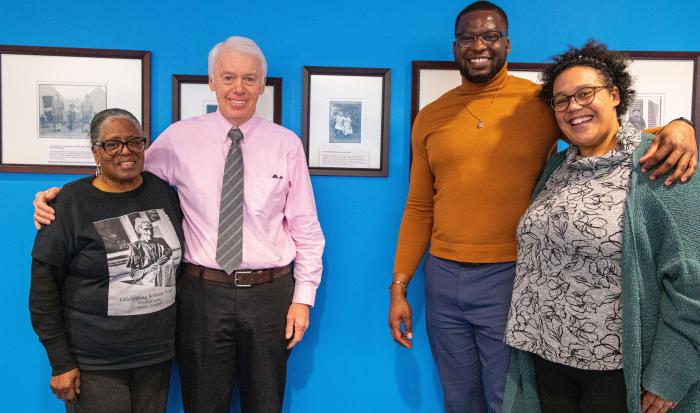
Local historian Frank Morrill didn't know he had come into possession of a photographic gold mine when he purchased a box of William Bullard's glass photo negatives in 2003. As a collector and former history teacher, he appreciated the historical context of the photos that were taken from 1897 to 1918, but it was a chance observation of his granddaughter much later that sparked a passion project. Morrill came to QCC on Thursday, March 9 to speak about Bullard's collection.
In 2013, Morrill's granddaughter Hannah was helping him review Bullard's streetscapes when she came across a mislabeled box that contained portraits. With a keen eye, she noticed that there was a tiny number written at the bottom of one of the negatives. Morrill recalled that a log book had been included in the purchase of the negatives and it corresponded to the photos. Bullard kept a detailed log of the people who sat for his photos. Morrill was fascinated and spent years researching the individuals through newspapers, business records, and interviews with their descendants.
William Bullard was born in Worcester in 1876 and took over 5,000 photographs throughout his life. Bullard covered many subjects such as factories, gravestones, and schools, which offered a detailed look at the culture of the time, from large blocks of ice being transported for sale or pies that cost 11 cents. But the true gem of his collection is the portraiture, especially the portraits of African-Americans who lived in Worcester.
The portraits show African-American individuals of all ages, many of whom were formerly enslaved in the southern U.S. Numerous people are posed on porches or in yards of homes that still stand in Worcester to this day. Some are in military uniforms in Green Hill Park or with bicycles, reflecting the popularity of cycling due to Major Taylor.
Morrill noted that there aren't many collections of African-American portraits from this time period. Even less common is that he was able to identify 80% of the sitters in the photos, thanks to Bullard's log book.
One such sitter was Lena Jackson. Jackson appeared as a young girl in a portrait from around 1900 accompanied by another young relative. Jackson's granddaughter Benetta Kuffour carries on the family history as a resident of Worcester and spoke at the event about her family's legacy. Through Jackson, Kuffour is also a descendant of Bethany Veney.
Veney was born into enslavement in Virginia in 1813. Kuffour mentioned that she worked for several different families throughout her time in Virginia, many of them known for their cruelty.
"She endured many challenges but always worked hard and found a way to take care of herself," Kuffour said.
In 1858, Veney's enslaver needed money so she was sold to a man in Rhode Island where she was given freedom. She worked for the family for years and then saved enough money to purchase a home in Worcester. She also made several trips back to Virginia to recover family members. Veney brought 16 people from her family to Worcester and bought several homes for them to live in.
Kuffour described Veney as a woman of strength and resilience and an advocate for justice. Her autobiography can be read in the Collected Stories of African American Women Writers.
Kuffour noted that it's important to share our history regardless of what your background is.
"Our story isn't just Black history, it's American history. If you don't know your history, do the research. It's important," she said.
There is still time to see the photos on display in HLC 109A/B the week of March 13.
